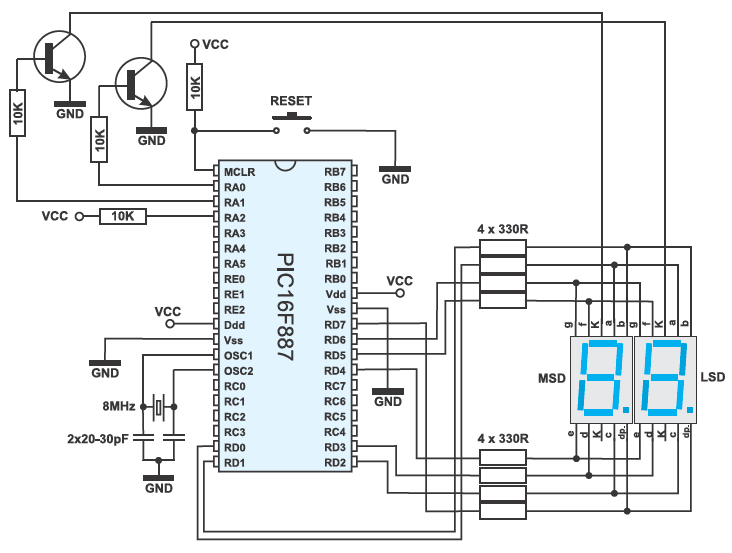Here the PIC16F887 is used as a two-digit counter . The variable i is incremented (slow enough to be visible) and its value is displayed on a two-digit LED display (99-0). The challenge is to enable a binary number to be converted in decimal and split it in two digits (tens and ones). Since the LED display segments are connected in parallel, it is necessary to ensure that they change fast in order to make impression of simultaneous light emission (time-division multiplexing).
In this example, timer TMR0 is in charge of the time-division multiplexing, while the mask function converts a binary number into decimal format.

/*Header******************************************************/
unsigned short mask(unsigned short num);
unsigned short digit_no, digit10, digit1, digit, i;
void interrupt() {
if (digit_no==0) {
PORTA = 0; // Turn off both displays
PORTD = digit1; // Set mask for displaying ones on PORTD
PORTA = 1; // Turn on display for ones (LSD)
digit_no = 1;
} else {
PORTA = 0; // Turn off both displays
PORTD = digit10; // Set mask for displaying tens on PORTD
PORTA = 2; // Turn on display for tens (MSD)
digit_no = 0;
}
TMR0 = 0; // Reset counter TMRO
INTCON = 0x20; // Bit T0IF=0, T0IE=1
}
void main() {
OPTION_REG = 0x80; // Set timer TMR0
TMR0 = 0;
INTCON = 0xA0; // Disable interrupt PEIE,INTE,RBIE,T0IE
PORTA = 0; // Turn off both displays
TRISA = 0; // All port A pins are configured as outputs
PORTD = 0; // Turn off all display segments
TRISD = 0; // All port D pins are configured as outputs
do {
for (i = 0; i<=99; i++) { // Count from 0 to 99
digit = i % 10u;
digit1 = mask(digit); // Prepare mask for displaying ones
digit = (char)(i / 10u) % 10u;
digit10 = mask(digit); // Prepare mask for displaying tens
Delay_ms(1000);
}
} while (1); // Endless loop
}
mask.c file:
/*Header******************************************************/
unsigned short mask(unsigned short num) {
switch (num) {
case 0 : return 0x3F;
case 1 : return 0x06;
case 2 : return 0x5B;
case 3 : return 0x4F;
case 4 : return 0x66;
case 5 : return 0x6D;
case 6 : return 0x7D;
case 7 : return 0x07;
case 8 : return 0x7F;
case 9 : return 0x6F;
}
}
0 comments:
Post a Comment